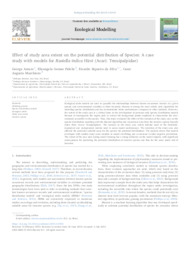Effect of study area extent on the potential distribution of Species: A case study with models for Raoiella indica Hirst (Acari: Tenuipalpidae).
Effect of study area extent on the potential distribution of Species: A case study with models for Raoiella indica Hirst (Acari: Tenuipalpidae).
Autoria: AMARO, G. C.; FIDELIS, E. G.; SILVA, R. S. da; MARCHIORO, C. A.
Resumo: Ecological niche models are used to quantify the relationships between known occurrence records of a given species and environmental variables at these locations. Maxent is among the most widely used algorithms for modeling species distribution and has demonstrated better performance compared to other methods. However, the extent of the study area is a critical issue in the development of presence-only species distribution models because it encompasses the region used to extract the background points employed to characterize the envi- ronments accessible to the species. Thus, this study evaluated the effect of the extension of the study area on the species distribution modeling with the Maxent algorithm and occurrence data from the invasive species Raoiella indica Hirst (Acari: Tenuipalpidae). The increase in the study area extent inflated most of the threshold- dependent and -independent metrics used to assess model performance. The selection of the study area also affected the predicted suitable areas for the species (its potential distribution). The analysis shows that models developed with smaller study areas resulted in model overfitting and an increase in false-negative predictions. The extent of the area used during model training has a strong influence on the model outputs, with significant consequences for predicting the potential distribution of invasive species and thus for the areas under risk of invasion.
Ano de publicação: 2023
Tipo de publicação: Artigo de periódico
Unidade: Embrapa Roraima
Palavras-chave: Ecological niche, Modeling process, Species distribution models, Study area extent, invasive species
Observações
1 - Por padrão são exibidas publicações dos últimos 20 anos. Para encontrar publicações mais antigas, configure o filtro ano de publicação, colocando o ano a partir do qual você deseja encontrar publicações. O filtro está na coluna da esquerda na busca acima.
2 - Para ler algumas publicações da Embrapa (apenas as que estão em formato ePub), é necessário ter, no celular ou computador, um desses softwares gratuitos. Sistemas Android: Google Play Livros; IOS: iBooks; Windows e Linux: software Calibre.
Acesse outras publicações
Acesse a Base de Dados da Pesquisa Agropecuária (BDPA) para consultar o acervo completo das bibliotecas da Embrapa.

